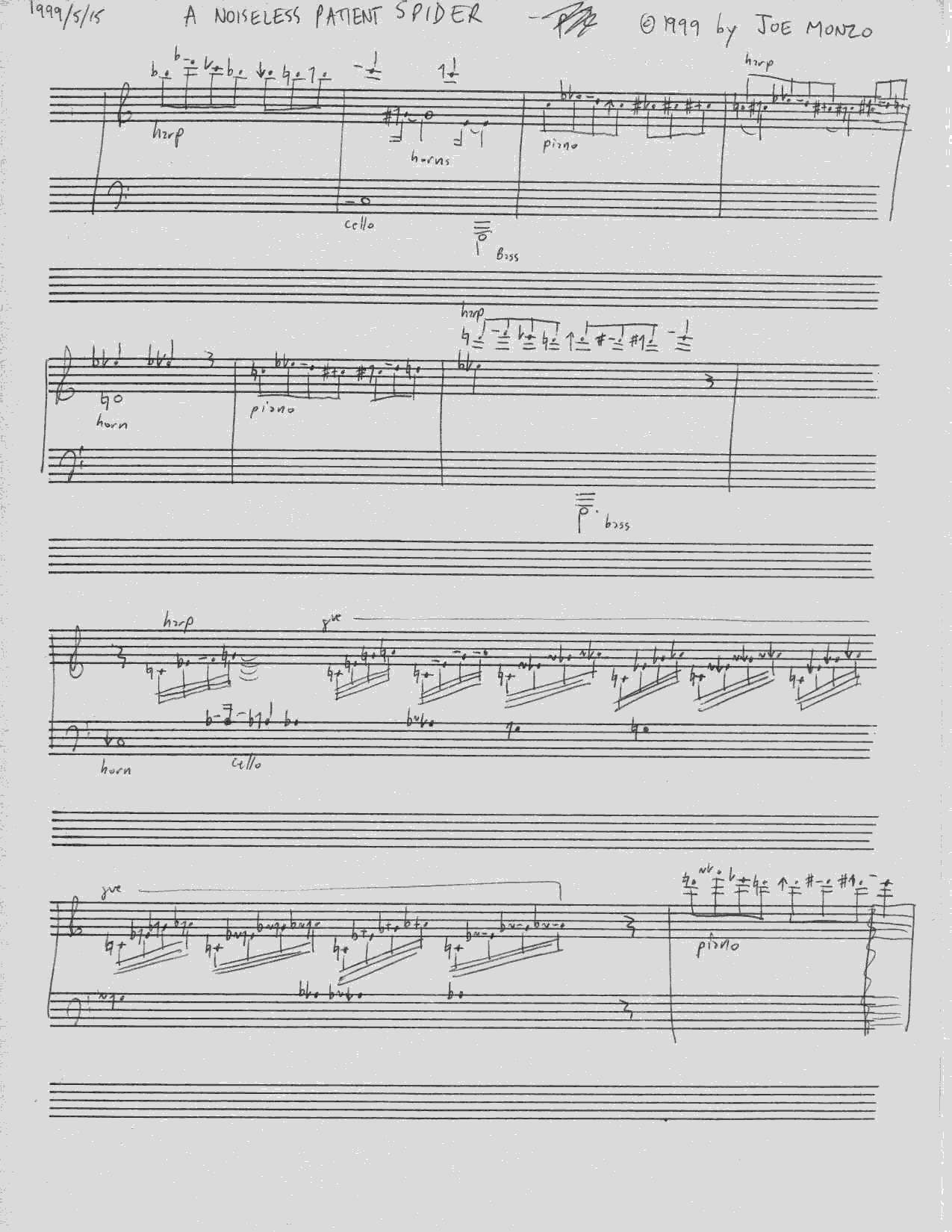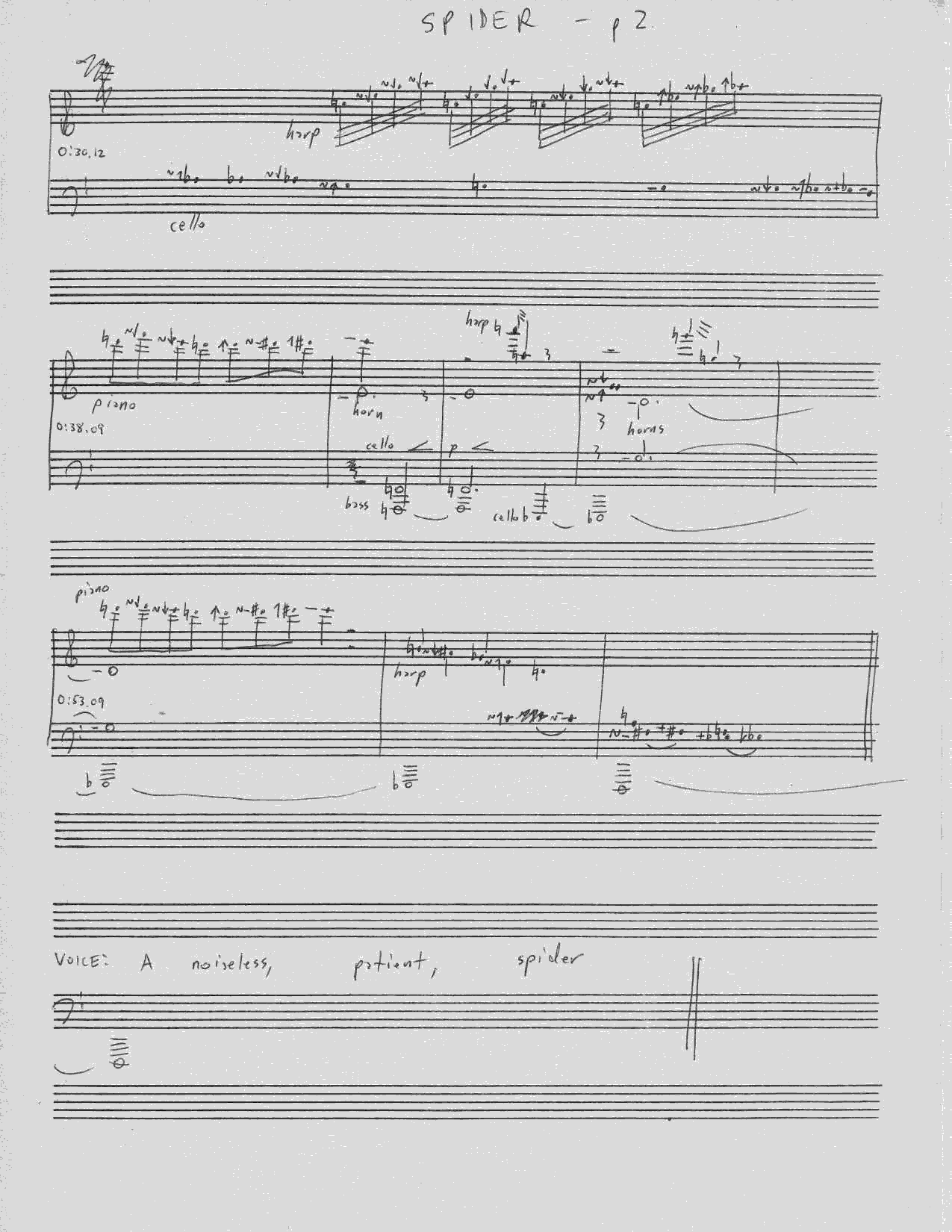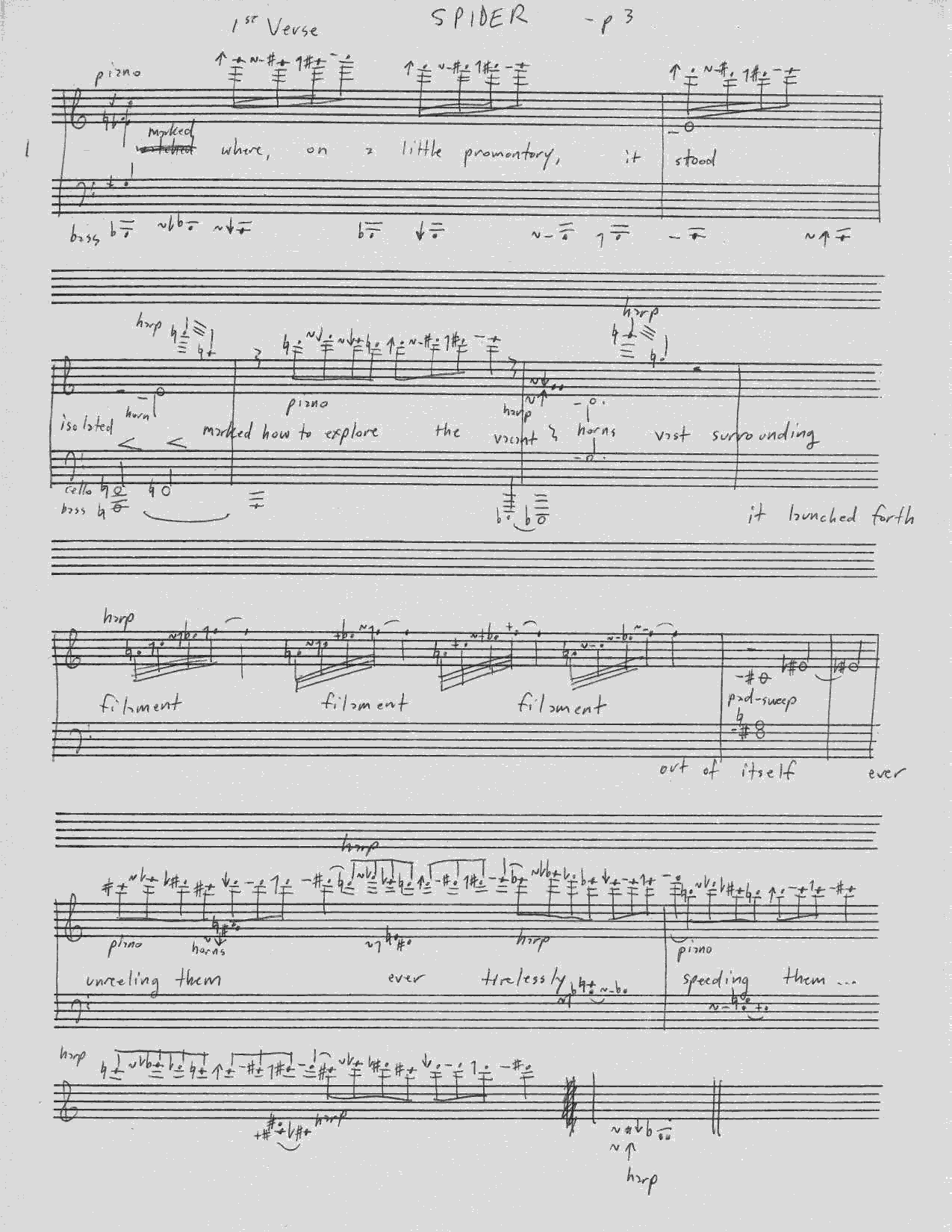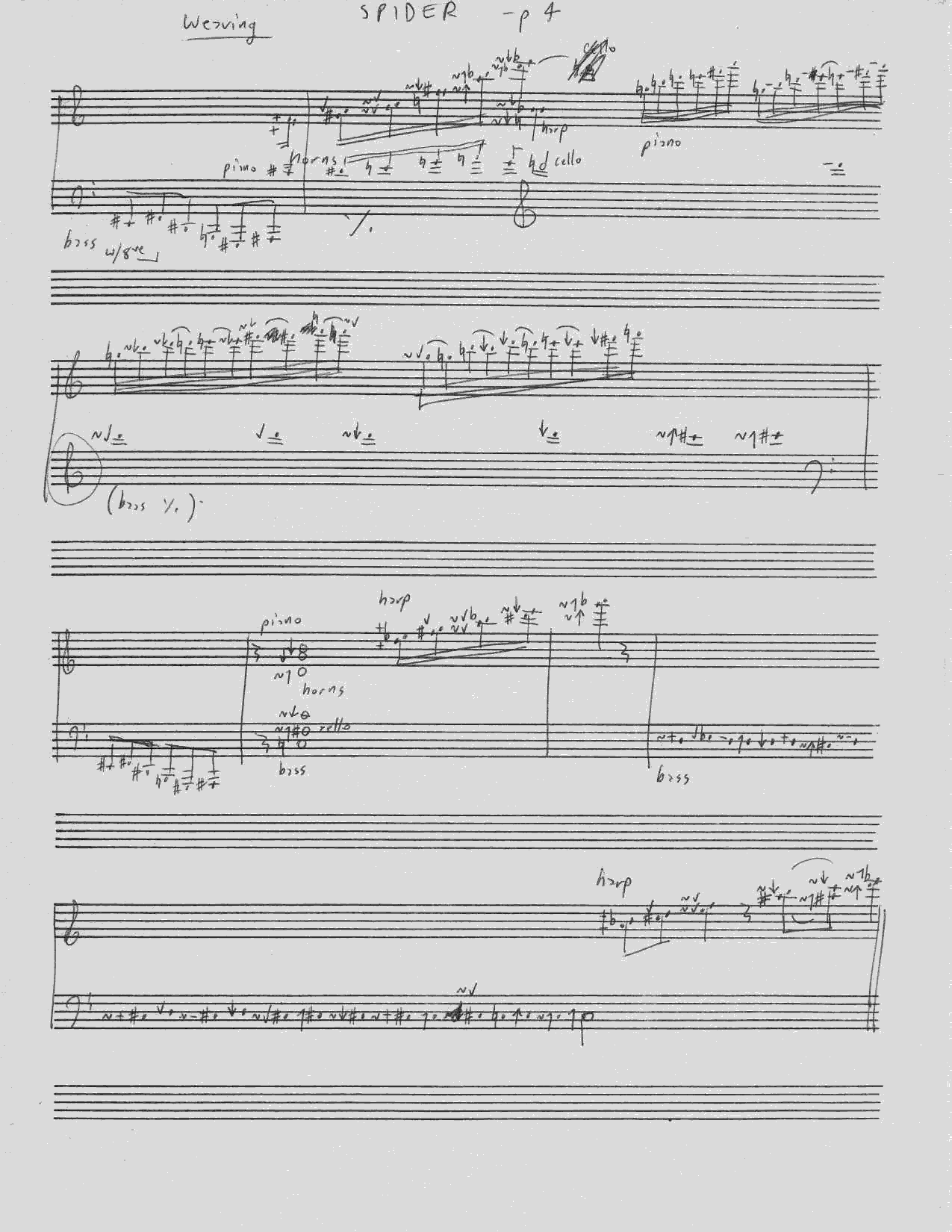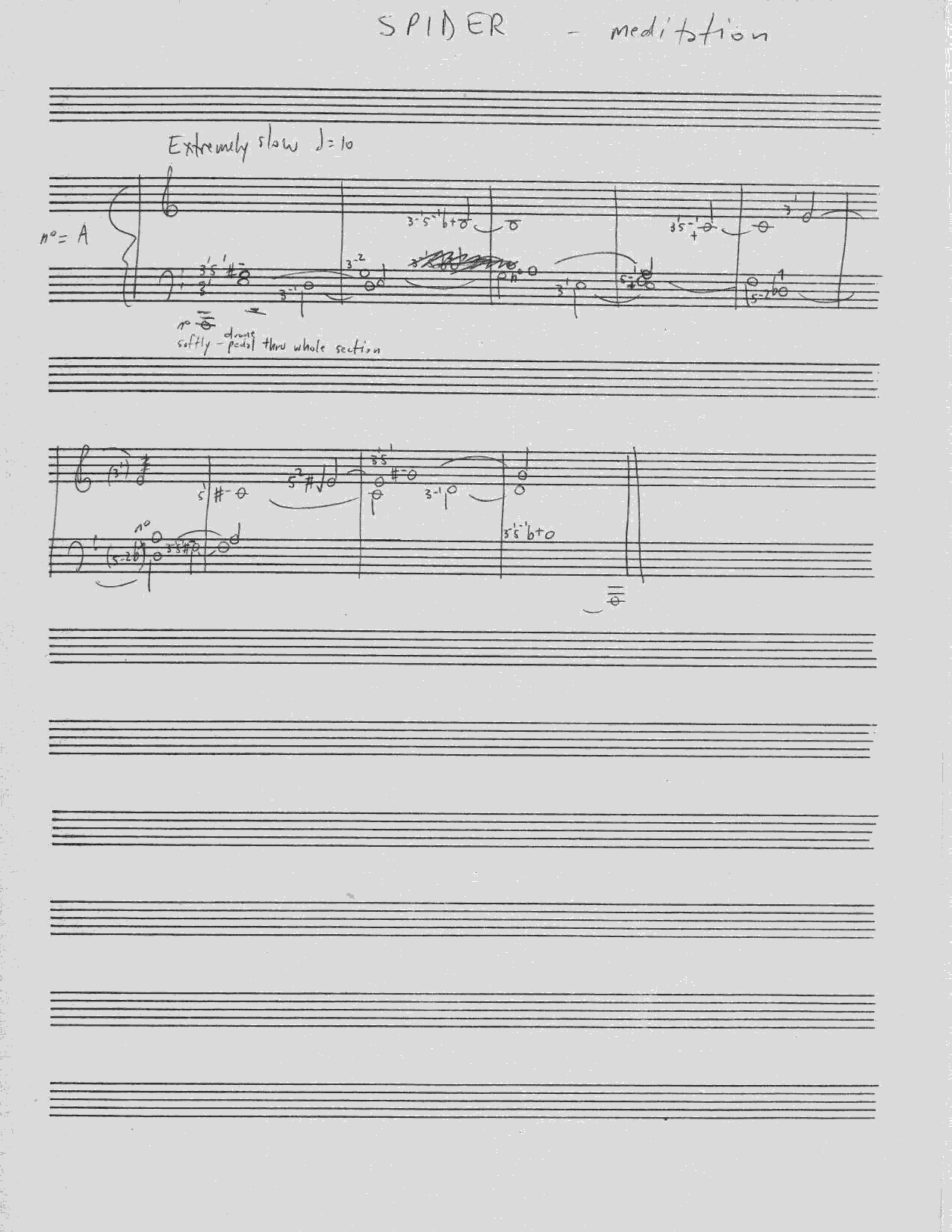A Noiseless Patient Spider
© 1999 by Joe Monzo
text by Walt Whitman
text by Walt Whitman
written May 1999
(Wait a bit while your browser downloads an mp3 of the opening section.)
MIDI sequence of the instrumental parts.
mp3 of the April 2001 Microfest performance in Claremont, CA (7.12 MB)
A NOISELESS PATIENT SPIDER
by Walt Whitman
A noiseless patient spider,
I mark'd where on a little promontory it stood isolated,
Mark'd how to explore the vacant vast surrounding,
It launch'd forth filament, filament, filament, out of itself,
Ever unreeling them, ever tirelessly speeding them.
And you O my soul where you stand,
Surrounded, detached, in measureless oceans of space,
Ceaselessly musing, venturing, throwing, seeking the spheres to connect them,
Till the bridge you will need be formed, till the ductile anchor hold,
Till the gossamer thread you fling catch somewhere, O my soul.
This has been my favorite poem for a number of years. In February, when Johnny Reinhard invited me to perform a piece at the 1999 AFMM, I decided right away that a setting of this poem was what I wanted to do.
It had been quite a few years since I last read Whitman's poem, and it wasn't until after I had decided to use this for my piece, and I read it again, that I remembered the bit about the 'bridge'. Those of you who are familiar with my music theory work know that I use this word to describe an important concept in tuning theory. (see bridge in my tuning dictionary)
Then one night, while pondering what to compose during my initial work on the project, I was looking at a lattice diagram I had drawn of Ptolemy's complete system of rational scales, and thinking about this piece, and it suddenly struck me how closely a complicated tonal lattice diagram resembles a spider web.
(In fact, after I had this idea, I ran across a score which very much resembles a spider web: Douglas Walker's JI chamber piece "... out of the fathomless Dark / into the limitless Light...", published in Xenharmonik˘n 7+8. The only difference is that a real web has a spiral thread winding around the center at progressively greater distances, while the scores for Walker's string parts use parallel concentric lines.)
So I took both of those as omens that I must finish and perform this piece. Combined with the strong feelings I have in favor of the WWWeb, this provided a powerful inspirational impetus.
The piece is in five sections:
(Click on the links to hear the first minute of an mp3 - "Meditation" is the only one that's seriously truncated.)
1. Introduction (instrumental)
2. A Noiseless Patient Spider (verse 1 of the poem)
3. Weaving (instrumental transition to part 4)
4. Meditation (instrumental)
5. You, O My Soul (verse 2 of the poem)
The performance includes two visuals: a poster of a spider and its web, which may be interpreted as a stylized representation of the complicated lattice diagram of the pitches in parts 1, 2, 3, and 5, on one side of the stage

and a poster of a lattice diagram of the rectangular and symmetrical 13-tone 5-limit JI system used in part 4, on the other side.

The poem is intoned as poetic speech rather than as a 'sung' vocal line (somewhat in the manner of Harry Partch), and the performer should personify someone who would be a combination of Walt Whitman and myself.
The themes portraying the poet's observance of the spider's diligence in spinning its web, in parts 1, 2, 3, and 5, are tuned in a combination of 12-eq and JI. Parts 1 and 2, setting the 1st verse, are intended to convey the 'patience' of the spider in the initial stages of weaving the web, with interspersed sonic images of its spatial isolation, while Part 3 portrays the spider's mounting industriousness as it completes the web.
A note on the temporal scale: this is a very short poem, only 2 verses of 5 lines each, and my rendition of it is a little over 7 minutes. I felt justified in stretching it out a bit because it's obvious to me, with my new knowledge of how spiders weave their webs, that Whitman's use of 'patient' at the beginning of the first verse and 'speeding' at the end of it reflects precisely the stages of a spider's activity, and covers the passage of about an hour - the length of time it takes for a spider to build its web. Since he turns to self-examination in the next verse, it seemed that a long contemplative phase would fit the piece well.
The 'Meditation', where the poet's thoughts turn inward, is tuned to the symmetrical 5-limit system centered on 'A' portrayed on the prime-factor lattice diagram - one kind of ultimate rational understanding of musical harmony - with a very soft drone on a low 'A'. The entire section uses only three main instrumental parts which each hold a pitch for six very slow beats as they move around the lattice.
These three parts overlap and explore various 5-limit triad subsets of the total lattice of 13 pitches, and about two-thirds of the way thru this section they form a 'first inversion A major' triad, but the '3rd of the chord' (in the bass) is not the 'correct' 5:8 ratio with the pitch C#-, but rather the 16:25 Db>, giving a proportion for the whole triad of 32:50:75, instead of 5:8:12, so the exploration continues.
It finally comes to an end when the triad forms the outline of an 'augmented 6th' chord on a Bb+ 'root', with the proportion 128:160:225, which strongly suggests a 'harmonic dominant 7th' chord with the proportion 4:5:7 [= 128:160:224].
This suggestion is due to the 224:225 'bridge' function of the highest pitch in the chord, the G#-, which was also the highest pitch in the first chord heard in this section. After this triad fades away, unresolved, a hint of the drone on 'A' can be heard as the section ends.
Part 5, which presents the 2nd and final verse of the poem, has the musical function of a recapitulation of the gestures in Parts 1, 2, and 3, but also including the entire Meditation section within it. Thus, the music reflect's the connections drawn by the poet between his observations of the spider and his meditation on his own work.
This material returns in faster tempo and combined with the 'web' material of the earlier sections, with the final Bb+ 'augmented 6th' chord of the 'Meditation' music resolving onto an 'A major 7th' chord at the word 'bridge' in the poem. This allows the note perceived as a 4:7 to the Bb+ to be recognized for what it really is, a 128:225 to the Bb+, which makes it a 8:15 to the central tonic 'A'. The piece ends with an allusion to the final part of the Introduction, finishing off the metaphor equating the poet's soul with the spider's activity.
The premier performance was the final piece of the 'Microthon 99', Sunday, May 23, 1999, at NYU's Physics Auditorium in New York City. (see Kyle Gann's Village Voice review)
Here is my sketchy score of Parts 1 thru 4. Note that most of the pitches are actually in just-intonation, but I never got around to writing the prime-factors into the score, except in Part 4 (or to writing down Part 5 at all). The notation I used is 144-EDO. I wrote the first two staff-systems in 72-EDO, but realized that it didn't offer enough pitch discrimination to accurate reflect many of my melodic gestures (for example, note that the second note played by the harp in measure 5 is slightly higher than the first note, but the 72-EDO notation gives them as the same). So from that point on I used 144-EDO. I also never got around to notating the pitches and ratios of the vocal part. (So far I'm the only one who's performed it.)
(Click on the small score page to open another webpage which has a full-size version of that score page ... you can then click the larger version to download an mp3 of it. The mp3's of the first four pages are complete. The mp3 of the last page, the "Meditation" section, is truncated quite a bit.)
(And here's the mp3 of the last section, which is not notated here, missing only the very ending.)
In collecting the links listed below, I have found out two things about spider webs which I find interesting:
First, after the spider has established, with 3 to 7 'proto-radii' threads, what is known as the 'proto-hub', which will eventually become the central hub of the web, it then builds the first 'frame thread' at the top of the structure, and this thread is also called the bridge thread.
(Arachnologists are encouraged to tell me whether this is a coincidence or whether the term was inspired by Whitman's poem: it's apparent to me from surfing the internet that you guys are understandably fond of this particular little piece of literature.)
Secondly, the design of a typical spider web resembles a structure defined by physicists as a crystal lattice, which relates it to an observation I made about my lattice diagrams, as well as to many lattices and tilings designed to represent tonal systems by Erv Wilson.
-
Samuel Zschokke's absorbing explanation of a typical example of
spider
web construction design and process. There's also a
movie of the spider at work, and links to a photo gallery of webs
of different species. (My web graphic is adapted from one of his photos.)
-
A great explanation of
crystal
lattice structures, with
some very cool VRML (virtual reality) diagrams.
The mathematics of these structures can also be applied to the tonal lattice diagrams used by myself and others for tuning and harmonic theory, the 'unit cell' of a crystal being analogous to Fokker's periodicity block. Follow the links to their other pages too.
-
An interesting explanation of how one video system used
vector-tracing
to produce a video of a web and its owner greeting 'visitors'
(= dinner). -
Scientists are considering using spiders as test-patients for
drugs instead of mammals, because the
stoned-spider
webs are deformed in ways that can be precisely measured according
to statistical crystallography, and correlated with the
amount and type of drug administered to the spider. Here's
another
page with the same information presented differently.
-
For everything you ever wanted to know about spiders and other
arachnids (including scorpions, ticks, mites, and daddy longlegs,
which - surprise! - are not spiders), visit the
Arachnology
Website.
[WARNING: not for the arachnophobic!!]
Updated:
1999.5.20 -- page created
1999.6.2
2001.4.24
2003.08.10 -- link to mp3 of Microfest 2001 performance added
|
or try some definitions. |
I welcome
feedback about this webpage:
|
